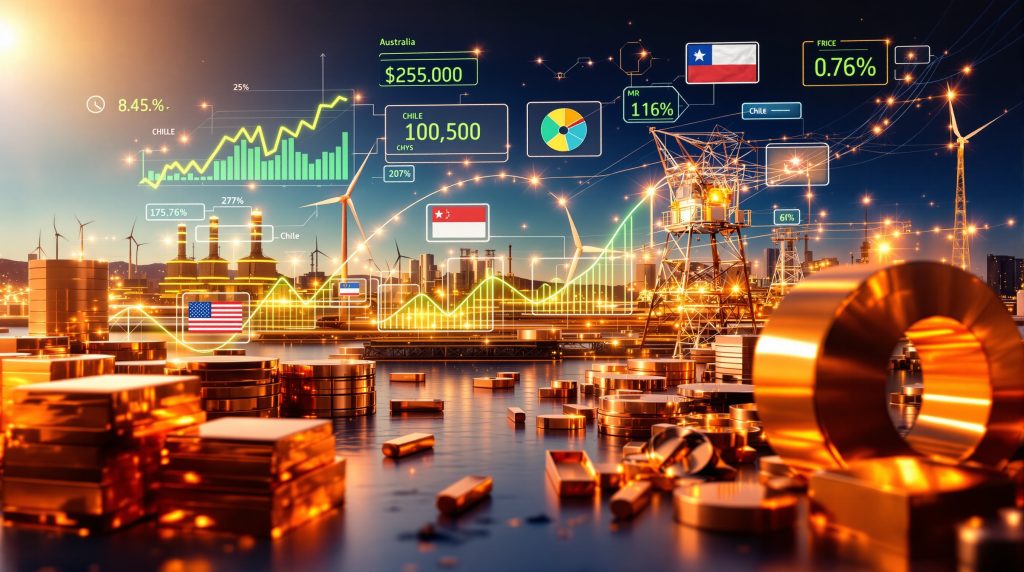Understanding the Structural Copper Investment Thesis
The convergence of technological transformation and resource scarcity has created an unprecedented investment landscape in copper markets. Unlike previous commodity cycles driven by singular economic factors, today's copper market investment opportunities emerge from multiple simultaneous disruptions reshaping global infrastructure demands over decades.
Modern economies face an electrification transition requiring dramatically increased copper consumption across transportation, energy storage, and digital infrastructure. This structural shift differs fundamentally from cyclical commodity trading, as demand drivers operate independently and reinforce each other through overlapping infrastructure requirements.
What Defines Today's Copper Investment Opportunity?
Electric vehicle manufacturing demonstrates the scale of this transition, requiring approximately 50-80 kg of copper per vehicle compared to 10-15 kg in conventional automobiles. With global EV sales reaching 14.0 million vehicles in 2023, representing a 35% year-on-year increase, the automotive sector alone creates sustained copper demand pressure.
Data centre expansion presents another significant demand catalyst, with artificial intelligence infrastructure consuming 2-3 tonnes of copper per megawatt of capacity for electrical distribution and cooling systems. Global data centre copper demand increases by an estimated 50,000-80,000 tonnes annually through 2030 as cloud computing infrastructure expands at 15-20% annually.
Key Investment Drivers:
• Grid modernisation projects across developed economies requiring 100,000-150,000 tonnes of additional copper annually
• Industrial reshoring initiatives increasing manufacturing copper intensity per production unit
• Renewable energy infrastructure deployment demanding enhanced transmission capacity
• 5G network rollouts necessitating upgraded electrical infrastructure
How Supply Constraints Create Investment Value
The copper mining industry faces structural challenges that traditional cyclical analysis underestimates. Average project development timelines have extended to 15-20+ years, with recent major projects averaging 16.8 years from exploration to commercial production. These extended development periods create persistent supply tightness independent of short-term demand fluctuations.
Global copper ore grades have declined from approximately 1.2% in the 1990s to 0.6-0.7% currently, requiring significantly increased mining volumes to maintain production levels. This grade deterioration affects established operations across major producing regions, constraining expansion potential from existing assets.
Supply-Side Investment Catalysts:
• Environmental permitting complexity limiting new project approvals across multiple jurisdictions
• Geopolitical concentration risks with Chile, Peru, and Democratic Republic of Congo controlling 64% of global output
• Capital allocation challenges as mining companies prioritise shareholder returns over expansion
• Water scarcity constraints in key producing regions affecting operational feasibility
Investment Vehicle Analysis: Comparing Copper Exposure Strategies
Copper market investment opportunities span multiple vehicle types, each offering distinct risk-return profiles and liquidity characteristics. Understanding these differences enables portfolio construction aligned with specific investment objectives and time horizons.
Direct Commodity Exposure vs. Equity Participation
| Investment Approach | Risk Profile | Return Potential | Liquidity | Capital Requirements | Management Fees |
|---|---|---|---|---|---|
| Physical Copper ETFs | Low-Medium | Tracks spot price | High | Moderate | 0.47-0.67% annually |
| Major Producer Equities | Medium | 2-4x price leverage | High | Moderate | Varies by fund |
| Mid-Tier Miners | High | 4-8x price leverage | Medium | Variable | N/A (direct equity) |
| Development Projects | Very High | 10-50x potential | Low-Medium | High | N/A (direct equity) |
| Copper Futures | Extreme | Maximum leverage | Very High | Low (margin) | Brokerage fees |
Physical copper exchange-traded funds provide direct exposure to spot prices but incur storage costs ranging $0.15-$0.35 per pound annually. These vehicles suit investors seeking copper exposure without operational or development risks, though returns remain limited to underlying commodity price appreciation.
Portfolio Construction Strategies
Conservative Allocation Framework (60% of copper exposure):
• Diversified mining companies with multiple commodity streams providing downside protection
• Established operations in stable jurisdictions with predictable regulatory environments
• Consistent dividend policies during commodity cycles supporting total returns
• Balance sheet strength enabling sustained operations through price volatility
Growth Allocation Framework (30% of copper exposure):
• Mid-tier producers with expansion pipelines offering production growth leverage
• Development projects approaching production with defined timelines
• Companies demonstrating proven management execution in similar projects
• Assets located in Tier 1 jurisdictions with established infrastructure
Speculative Allocation Framework (10% of copper exposure):
• Early-stage exploration companies with significant resource potential
• Innovative extraction technologies offering competitive advantages
• Jurisdictional arbitrage opportunities in emerging mining regions
• Special situation investments requiring active management
Major Producer Analysis
BHP Group operates as the world's largest copper producer, providing diversified commodity exposure through iron ore, nickel, and metallurgical coal operations. The company's Australian Copper SA division maintains unit cost guidance of US$1.00-$1.50 per pound, offering competitive positioning despite declining ore grades affecting global producers.
Sandfire Resources maintains market capitalisation of approximately $7.52 billion with quarterly copper production exceeding 24,000 tonnes, ranking among the top 25 global copper producers. The company's focused copper exposure provides direct leverage to commodity price appreciation without diversification dilution.
Geographic Investment Considerations
Jurisdictional selection significantly impacts copper investment returns through regulatory predictability, infrastructure quality, and political stability. These factors often outweigh geological endowments in determining long-term portfolio performance.
Why Jurisdiction Selection Drives Returns
Tier 1 Investment Jurisdictions:
Australia offers regulatory approval timelines averaging 3-5 years for major mining projects, combined with established mining taxation frameworks. Furthermore, the country hosts approximately 9 million tonnes of proven copper reserves and produced 850,000 tonnes in 2023, with mining technology innovations benefiting from advanced infrastructure and skilled labour availability.
Chile dominates global copper production with 28% of worldwide output (approximately 5.5 million tonnes in 2023) and 200 million tonnes of proven reserves representing 37.5% of global totals. Chilean copper mining benefits from Pacific port proximity, reducing transportation costs by 60-70% compared to landlocked regions.
Canada provides mining regulation predictability through established provincial frameworks, though permitting timelines average 5-7 years with some jurisdictions experiencing 8-12 year delays for major projects. The country maintains 12 million tonnes of proven reserves with strong environmental compliance standards.
The us copper production overview reveals that operations face extended permitting processes averaging 7-12 years, significantly longer than other Tier 1 jurisdictions despite abundant resources. The country holds 42 million tonnes of proven reserves but produces only 1.3 million tonnes annually, indicating substantial underdeveloped potential.
Infrastructure Proximity as Investment Factor
Transportation costs create substantial competitive advantages for certain copper assets, ranging $50-$150 per tonne depending on distance and logistics infrastructure. Australian copper exports benefit from established port facilities with transportation costs averaging $30-$60 per tonne, while Chilean operations achieve similar cost efficiency through Pacific port proximity.
Critical Infrastructure Factors:
• Power availability affecting operational costs, with copper mining requiring 4-6 megawatt-hours per tonne of refined copper
• Water access particularly crucial in arid regions, with average operations consuming 15-25 million cubic metres annually
• Railway and trucking infrastructure determining transportation economics
• Port capacity and scheduling affecting export timing and costs
Emerging Market Opportunities
Peru maintains 81 million tonnes of proven reserves (15.2% of global totals) and produces 2.1 million tonnes annually. However, political instability has disrupted production by 8-10% in recent years, with five government changes between 2021-2024 creating regulatory uncertainty.
Democratic Republic of Congo offers 21 million tonnes of proven reserves but experiences production disruptions averaging 15-20% annually due to security concerns and limited infrastructure. The concentration of production in Katanga Province creates both operational efficiency and risk concentration.
Zambia presents development opportunities with 1.8 million tonnes of proven reserves, though production has declined from 800,000 tonnes in 2015 to 630,000 tonnes in 2023 due to electrical grid constraints and declining ore grades.
Market Timing and Entry Strategies
Copper price cycles provide extended windows for strategic positioning, unlike financial markets where timing opportunities may be brief. Understanding these dynamics helps optimise entry points across different investment vehicles.
How Copper Price Cycles Affect Investment Timing
Current copper price prediction models show prices trading in the $10,000-$11,000 per tonne range on the London Metal Exchange, with industry forecasts projecting $13,000 per tonne by late 2026. This represents potential 18-30% upside from current levels, though timing remains dependent on supply disruptions and demand acceleration.
Supply Tightness Indicators:
• LME copper inventory levels reaching decade-lows of 85,000 tonnes in late 2023, compared to historical averages of 300,000-600,000 tonnes
• Current inventory representing approximately 0.4 days of global consumption versus historical norms of 1.5-3.0 days
• Forward curve backwardation signalling tight physical supply conditions
• Production disruption frequency increasing due to operational and political factors
Demand Growth Projections:
Market analysis indicates copper demand expansion of 2.8% annually through 2026, driven primarily by electrification infrastructure. The International Energy Agency projects supply shortfalls reaching 30% by 2035 under current development scenarios, suggesting sustained pricing pressure.
The global copper supply forecast indicates growth expectations remain modest at 1.2% in 2025 and 2.2% in 2026, creating projected deficits of 230,000 tonnes in 2025 escalating to 400,000+ tonnes in 2026. These structural imbalances support higher price trajectories independent of cyclical factors.
Dollar-Cost Averaging vs. Tactical Allocation
Systematic investment approaches often outperform timing attempts given copper's 18-25% annualised volatility over recent decades. However, major structural shifts can create compelling tactical opportunities for sophisticated investors.
Systematic Approach Benefits:
• Reduces impact of short-term price volatility on portfolio returns
• Captures long-term structural trends without timing requirements
• Minimises emotional decision-making during volatile periods
• Provides consistent market exposure across cycle phases
Risk Management in Copper Investments
While structural copper demand appears compelling, several risk factors could significantly impact investment performance. Understanding these risks enables better portfolio construction and appropriate position sizing.
What Factors Threaten Copper Investment Returns?
Demand-Side Risks:
Electric vehicle adoption rates may prove slower than projected, particularly if battery technology alternatives emerge or charging infrastructure development lags expectations. Economic recession could reduce industrial copper consumption across construction, manufacturing, and infrastructure sectors.
Technology Substitution Risks:
• Aluminium adoption in power transmission applications where weight advantages offset conductivity differences
• Wireless technology reducing copper wiring requirements in telecommunications and building infrastructure
• Advanced alloys improving copper efficiency, reducing total consumption per application
• Carbon nanotube development potentially offering superior electrical conductivity properties
Supply-Side Upside Risks:
Technological breakthroughs in extraction efficiency could increase recoverable reserves from existing operations. New deposit discoveries in accessible locations might alleviate supply constraints more rapidly than anticipated.
Recycling technology improvements could reduce primary copper demand, as recycled copper maintains identical properties to newly mined material. Current recycling rates approach 35% globally, with potential for significant expansion.
How to Hedge Copper Investment Exposure
Options-Based Hedging:
Put options on copper futures provide downside protection while maintaining upside participation. These instruments typically cost 2-4% of position value annually for at-the-money protection, varying with market volatility.
Portfolio Diversification:
• Currency hedging for international mining investments exposed to USD copper pricing
• Diversification across multiple commodity exposures reducing copper-specific concentration
• Geographic diversification across mining jurisdictions
• Development stage diversification balancing production and development assets
Technology and Innovation Impact
Technological advancement in copper extraction and processing can dramatically alter operational economics and development project viability. These innovations create both opportunities and threats for copper investors.
How Mining Technology Affects Investment Outcomes
Autonomous Equipment Implementation:
Mining companies increasingly deploy autonomous haulage systems and drilling equipment, reducing operational costs by 15-25% while improving safety metrics. These technologies particularly benefit large-scale operations with standardised processes.
Enhanced Recovery Technologies:
Improved ore processing techniques increase copper recovery rates from existing operations, effectively expanding reserves without additional mining. Bioleaching and other innovative processing methods enable economic extraction from previously marginal ore bodies.
Environmental Technology Integration:
Advanced water treatment and tailings management systems reduce environmental compliance costs while enabling operations in water-scarce regions. These technologies become increasingly important as environmental regulations tighten globally.
Alternative Materials and Substitution Risks
Research into alternative materials continues advancing, though copper's unique combination of electrical conductivity, thermal properties, and corrosion resistance makes direct substitution difficult in many applications.
Substitution Monitoring Areas:
• High-voltage power transmission where aluminium offers weight advantages despite lower conductivity
• Building wiring applications where fibre optic technology reduces copper requirements
• Heat exchanger applications where alternative materials provide corrosion resistance benefits
• Electronic applications where printed circuits may utilise alternative conductive materials
ESG Considerations in Copper Investing
Environmental, social, and governance factors increasingly influence copper investment returns through regulatory compliance costs, social licence to operate, and capital market access.
Why Environmental Standards Drive Investment Performance
Water usage efficiency becomes critical in arid mining regions, with Chilean copper mining consuming 65% of total mining water usage. Average copper operations require 15-25 million cubic metres annually, creating significant environmental and social challenges in water-scarce regions.
ESG Investment Factors:
• Community relations and indigenous rights compliance affecting operational continuity
• Carbon footprint reduction initiatives influencing investor allocation decisions
• Waste management and tailings safety protocols preventing operational disruptions
• Biodiversity protection measures increasingly required for project approvals
How Sustainable Mining Creates Value
Companies demonstrating environmental leadership often command valuation premiums and enjoy preferential access to capital markets. ESG-focused institutional investors control approximately $30 trillion in assets globally, creating demand for responsibly operated mining investments.
Value Creation Mechanisms:
• Lower cost of capital through ESG investor access
• Reduced regulatory compliance costs through proactive environmental management
• Operational risk mitigation through community stakeholder engagement
• Brand value enhancement supporting premium product pricing
Future Outlook and Strategic Positioning
The convergence of electrification trends, supply constraints, and geopolitical factors suggests copper investments may outperform broader commodity indices over extended periods. Success requires careful selection and active portfolio management.
What the Next Decade Holds for Copper Investors
Long-Term Investment Catalysts:
Global net-zero commitments require massive infrastructure investment, with renewable energy systems consuming 4-5 times more copper per unit of capacity than conventional power generation. Artificial intelligence infrastructure drives unprecedented data centre construction, with each facility requiring thousands of tonnes of copper for electrical distribution.
Electric grid modernisation across developed economies addresses aging infrastructure while accommodating renewable energy integration and electric vehicle charging networks. Industrial automation increases copper intensity per unit of production as manufacturing processes become more electrically sophisticated.
Market Structure Evolution:
However, the copper market appears transitioning from cyclical commodity trading to strategic resource positioning, similar to rare earth elements or lithium. This structural shift may reduce price volatility while supporting higher average price levels. Nevertheless, potential trade war copper impact factors could influence short-term pricing dynamics.
Building a Resilient Copper Investment Portfolio
Portfolio Construction Principles:
• Diversify across major producers offering stability and development projects providing leverage
• Balance geographic exposure across multiple stable jurisdictions while avoiding concentration risks
• Include both pure-play copper assets and diversified miners for risk management
• Maintain liquidity for tactical rebalancing as market conditions evolve
Active Management Requirements:
Regular portfolio review assesses changing risk profiles as development projects advance through construction phases. Risk assessment protocols monitor geopolitical developments, technological advancement, and demand pattern evolution affecting long-term investment thesis validity.
Entry Strategy Optimisation:
Current market conditions suggest selective opportunities across development stages, with established producers offering stability and development projects providing leverage to structural demand growth. For instance, copper investment opportunities are beginning to take shape on the ASX, while copper's potential decade-long bull run appears to be beginning. The timing appears favourable for investors willing to position early in this multi-decade transition cycle.
Investment Disclaimer: Copper market investment opportunities carry significant risks including commodity price volatility, operational challenges, and geopolitical uncertainties. This analysis represents market overview information and should not be considered personalised investment advice. Investors should conduct thorough due diligence and consider consulting qualified financial advisors before making investment decisions.
Looking to Capitalise on the Copper Investment Opportunity?
Discovery Alert's proprietary Discovery IQ model delivers real-time alerts on significant copper discoveries across the ASX, instantly empowering subscribers to identify actionable opportunities ahead of the broader market. Begin your 30-day free trial today at Discovery Alert and secure your market-leading advantage in this transformative commodity cycle.




